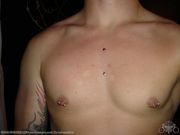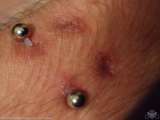Surface piercings
A surface piercing is a piercing where the entrance and exit holes are (usually) pierced through the same flat area of skin.
FIRST, LET ONE THING BE VERY CLEAR: Most surface piercings fail, not because surface piercings are impossible, but because there are a lot of totally incompetent piercers out there that don't understand how the body heals. SO GO TO AN EXPERIENCED PIERCER THAT CAN SHOW YOU HEALED PHOTOS OF SURFACE PIERCINGS THEY'VE DONE!
Jewelry
Traditionally, surface piercings were simply done using the same method as regular piercings - with a straight or curved metal bar. This is about the worst way to do a surface piercing, and while a small percentage of people have healed them, they tend to be temporary. The jewelry puts a great deal of pressure on the healing skin above it, and its inflexibility causes even more stress as the skin moves.
Flexible jewelry has become popular recently in hopes that it will decrease pressure on the piercing, but is considered to be less reliable than the surface bar.
Surface bars are on of perhaps the best and only proper jewelry for healing surface piercings because its perpendicular design was based on optimizing the body's healing process.
Healing and Aftercare
Many piercers are not comfortable doing surface piercings because they are difficult to heal, and most of them reject. Rejection means that the body slowly (or sometimes quickly) pushes them out through the skin, in the same way that the body pushes out a buried splinter. A surface piercing will only heal if it is easier for your body to keep the piercing in than it is to reject it. Since your body is designed to reject foreign objects, a little common sense makes it clear that it's not easy to keep a surface piercing.
For more information, see Surface Piercing Rejection.
Popular Surface Piercings
Related Risks
See Also
Category page: '

